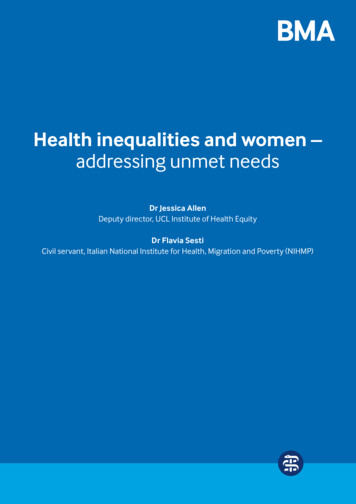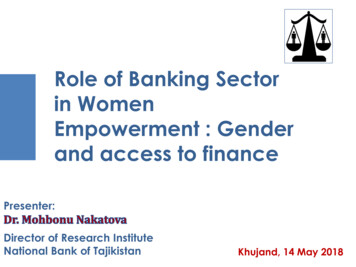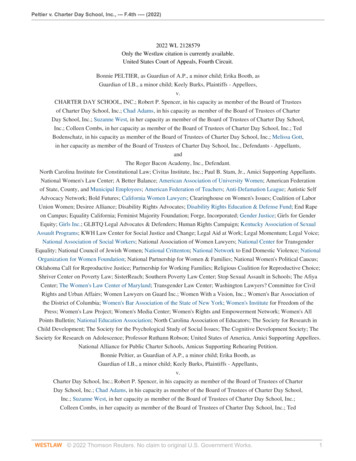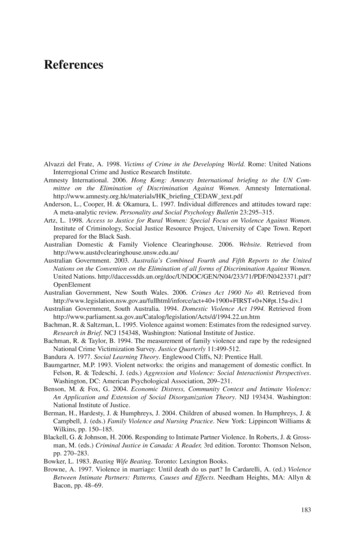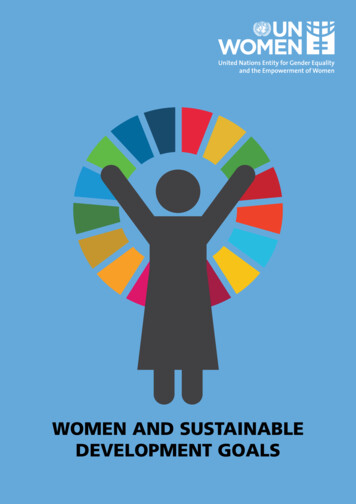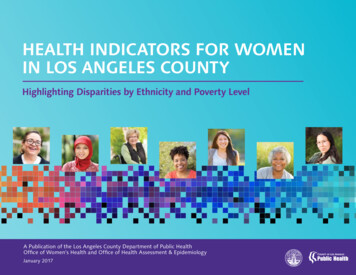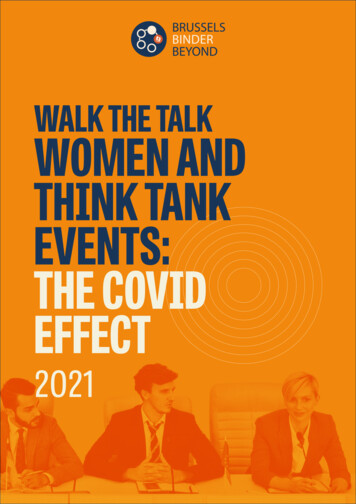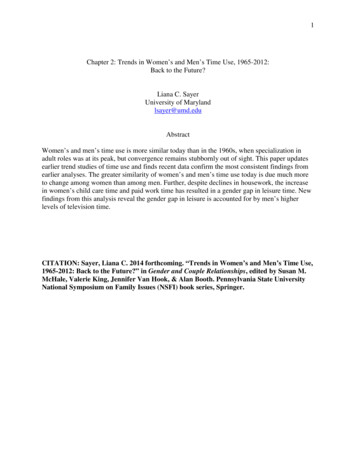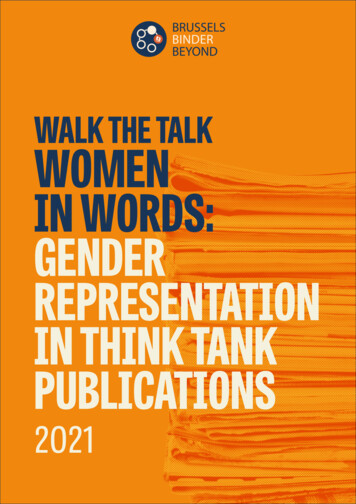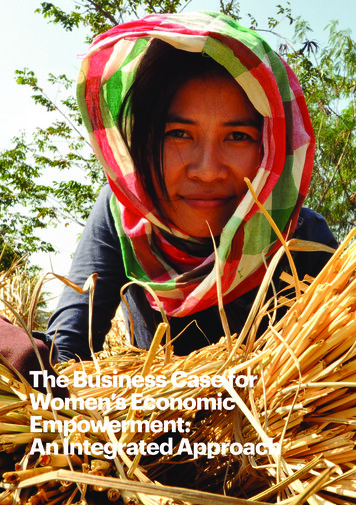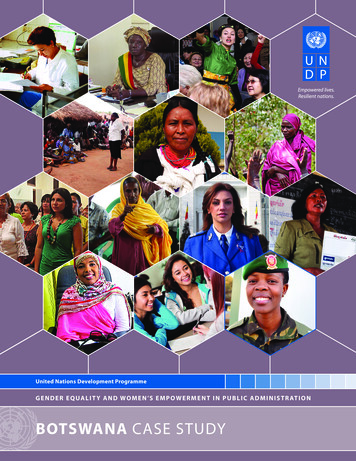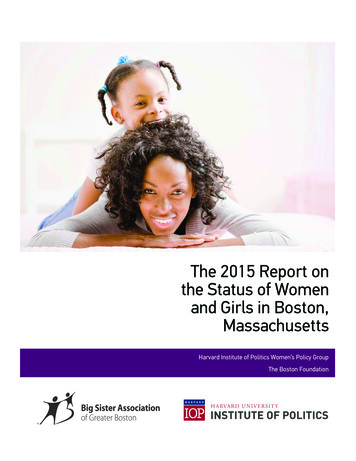
Transcription
The 2015 Report onthe Status of Womenand Girls in Boston,MassachusettsHarvard Institute of Politics Women’s Policy GroupThe Boston Foundation
Harvard Institute of Politics Women’s Policy Group / The Boston FoundationLeadership TeamBernadette Lim, Harvard ‘16Anna Menzel, Demographics Section Leader, Harvard ‘15Eva Shang, Education Section Leader, Harvard ‘17Emilia San Miguel, Violence Section Leader, Harvard ‘16Michelle S. Lee, Mental and Physical Health Section Leader, Harvard ‘16Annie Ryu, Editor-in-Chief, Harvard ‘13Contributing AuthorsAbigail Gabrieli, Harvard ‘17Anastasia Moran, Harvard ‘17Diana Im, Harvard ‘17Michelle Lee, Harvard ‘15Johanna Lee, Harvard ‘16Molly Dillaway, Harvard ‘15Leena Raza, Harvard ‘16Clara McNulty-Finn, Harvard ‘17Board of Advisors and EditorsLaura Simolaris, Advisor, Women’s Initiative in Leadership at the Harvard Institute of PoliticsGina Helfrich, Director, Harvard Women’s CenterChiwen Bao, Lecturer, Department of Social Studies and Studies of Women, Gender, andSexuality at Harvard UniversityAlicia Oeser, Education Specialist, Harvard Office of Sexual Assault and Prevention ResponseKalya Murray, Director, Girls’ Initiative of MassachusettsAmy Leung, Program Manager, Boston Women’s FundMargot Phelps, Director, Big Sister Association of Greater Boston2
The 2015 Report on the Status of Women and Girls in Boston, MassachusettsLetter from the AuthorsIt is our pleasure to present the 2015 Report on the Status of Women and Girls in Boston, Massachusetts. As ateam of 14 undergraduates hailing from nearly every corner of the nation, we sought to better understand a placewe can call a home and city to all of us: Boston. As passionate advocates for women and girls, we are humbled tolive in one of the most progressive cities in the nation. However, in spite of its progress, Boston still has work todo. Today, Boston still has a significant gender wage gap and violence in its neighborhoods that acutely affect thelivelihood of women and girls today. Through this report, we aim to highlight Boston’s progress for women andcall attention to areas in need of improvement. Most of all, we aim to create a publicly accessible, accurate, easyto-read resource for everyone to know the most recent status of women and girls in Boston in 2013.During spring 2013, I took a class at the Harvard Kennedy School called Philanthropy and Public Problem Solving.Together with Annie Ryu (who was at the time a graduating senior), I analyzed the effectiveness of non-profit organizations throughout Boston that promoted the cause of girls’ empowerment. As the first step of that process,Annie and I had to research underlying problem areas that particularly affected women and girls in Boston. Wespent hours on Google scourging various sources and extrapolating statistics from dense research reports. Theresearch process was exceptionally difficult, and our results were incomplete and inconclusive. We had a difficultyevaluating and interacting with girls’ and women’s organizations without knowledge of the problems that affectedwomen and girls in Boston in the first place. There was no comprehensive resource that compiled the currentstate of women and girls in health, education, and violence in Boston.In high school, I attended a conference that publicized the first report on women and girls in California held byMount St. Mary’s College. After realizing the difficulty of the research process in my philanthropy class, I realizedthat the creation of a similar report specific to Boston would be an invaluable resource to current and future government leaders, organizations, and philanthropists in Boston regarding policy and programming for women andgirls in Boston. And so the fruition of this report began.While this began in response to a class project, this report evolved into a collaborative effort among a passionategroup of undergraduate women researchers. Together, we have authored and shaped this report. We have collected and analyzed secondary data from a multitude of sources dating as recent as 2013 and as far back as 2005regarding the state of women and girls in Boston. As a research team, we gathered the most recent informationabout women and girls in four key areas: Demographics, Education and Earnings, Mental and Physical Health,and Violence. We have also included a special feature on women in the LGBTQ community, a topic that has longbeen neglected in reports about women and girls. Additionally, we include sections about political participationand representation, women in the military, and women in business.We hope that this resource is of assistance, encouragement, and knowledge, and that one day, this report willreflect the equal opportunity and livelihood of women and girls in Boston.On behalf of the Harvard Women’s Policy Group,Bernadette Lim3
Harvard Institute of Politics Women’s Policy Group / The Boston FoundationWhy This Report MattersThis report is intended to: Highlight main issue areas, disparities, and gaps, and accomplishmentsregarding women and girls that are of the most current statistics Be a resource on problem-driven policy, solutions, and programs for stakeholders (i.e. policymakers, non-profit organizations, community leaders, etc.)involved in gender equity Be a call to action to 1) generate more recent and publicly accessible data forissue areas that lack data and 2) create and/or revamp programs and policiesto better tackle pressing issue areas with the greatest needHow to the Read this ReportEach section highlights the status of women and girls in different areas. The fourmain sections are: Demographics, Education and Earnings, Mental and PhysicalHealth, and Violence.Each of these sections includes: A box of important points of interest, which highlight the important takeaways you should take from this section. A detailed analysis on various sub-topics within each section. We also have a special feature on LGBTQ Women, Political Participation andRepresentation of Women, Women in the Military, and Women in Business.These smaller sections were authored by Abigail Gabrieli and AnastasiaMoran and apply a greater detailed analysis of the state of women in each ofthese areas.We would like to thank the Boston Foundation, who played a facilitative and consultative role to the Harvard Women’s Policy Group, referring resources and servingas the host of the Group’s Girls’ Empowerment Fund, funds of which were used tocontract consultants, designers, and printers.4
The 2015 Report on the Status of Women and Girls in Boston, MassachusettsTABLE OF CONTENTSDEMOGRAPHICS . pg. 6Gender Demographics of BostonAge Demographics of BostonImmigration & EthnicityHousingEDUCATION AND EARNINGS. pg. 10College Attendance and Graduation RatesAchievement on Standardized TestsEmploymentEarningsThe Pay Gap and EducationIndustry And Occupations Pay GapMENTAL AND PHYSICAL HEALTH. pg. 17Nutrition and ObesityDepression and SuicideChronic DiseaseSubstance AbuseMaternal HealthInfant MortalityVIOLENCE. pg. 25Human TraffickingFemale OffendersDomestic ViolenceSexual AssaultWOMEN IN THE LGBTQ COMMUNITY. pg. 29TerminologySame-Sex Attracted WomenTrans* WomenGovernment ActionPOLITICAL REPRESENTATION & PARTICIPATION. pg. 33Female LegislatorsBoston City CouncilPOLITICAL PARTICIPATIONWOMEN IN THE MILITARY. pg. 36Currently Active in DutyVeteransHomelessnessWOMEN IN BUSINESS. pg. 38LeadershipWomen-Owned BusinessEntrepreneurshipSOURCES. pg. 425
DEMOGRAPHICSBy Anna Menzel, Michelle Lee, Abigail GabrieliI m p o r ta n t P o i n t s o f I n t e r e s t :The Boston female population is relatively young, with 34.6% of Boston’s female population between the ages of 20-34. Overall, 52.1% of Boston’s city population is women and girls.Boston females are the majority-minority, More than 80% of Roxbury, Dorchester, Mattapan, and East Boston are comprised of ethnic minorities. In contrast, over 60% of neighborhoods of Back Bay and Beacon Hill are white.70.9% of family households in poverty in Boston are female-headed households without a husband present. This is compared to married-couple families as 21.2% and malehouseholder (no wife present) households as 7.8% of family households in poverty.The race of females in poverty is different than the race of females overall in Boston.69.7% of females in poverty in Boston are non-white, while only 54% of all females in Bostonare non-white.6
Male47.90%Female52.10%The 2015 Report on the Status of Women and Girls in Boston, MassachusettsGENDER DEMOGRAPHICS OF BOSTONWomen account for 52.1% of Boston’s population as home to 321,643Gender Demographics of Boston women and girls according to the 2010 U.S. Census Bureau. This is a5.3% increase since 2000.Dorchester has the highest female population of all Boston neighborhoods, accounting for 18.8% of the city’s female population. Roxbury,Brighton, and Jamaica Plain have the next highest female populations.*(insert chart of populations in appendix) According to the Boston FounMaleFemaledation’s 2011 “The Measure of Poverty: A48%52%Boston Indicators Project Special Report”,households at or below poverty and thosewith low educational attainment are concentrated in Roxbury/Dorchester/Mattapanneighborhoods. This area also representsMassachusetts’child poverty, with 42% of its children livMalelargest concentration ofFemaleing in impoverished conditions.AGE DEMOGRAPHICS OF BOSTON0-199.30%Boston’s population has remained relatively steady in the prior decade and iscomposed of a larger percentage of middle-aged individuals with the medianage of residents at 31. Boston is composed of about 6% children under theage of 5, and 20% under the age of 18 (2012 American Community Survey).20-3435-5455-6465 This isgroup is 0%11.50% the neighborhoodsand are especially concentrated in the southern neighborhoods of Boston asdisplayed above.—Source: Census 201034.6% of Boston’s female popula- Age of Boston’s Female PopulationAge of Boston’s Female Population tion is comprised of individuals20-34, a reflection of the collegeand universities in the area. Com65 0-1912% 9%paratively, only 19.8% of females inthe U.S. are in this age group. An55-64other important element to notice21%20-34is that the population dramatically35%drops for those over age 65. Thisis potentially due to the high cost35-5423%of living in Boston and the city’simage as a center for workingprofessionals. According to0-1920-3435-5455-6465 Forbes, Boston was ranked the #1 best city for recent college grads in2012. — Source: American Community Survey 201211.5% 9.3%0-1965 21.2%34.6%55-6420-3423.3%35-547
Harvard Institute of Politics Women’s Policy Group / The Boston FoundationWhiteIMMIGRATION& ETHNICITYIN BOSTONBlack/HispanicAsianOtherAfricanBostonis a city rich in diversity. As of 2010, over half of the Boston’s populationAmerican46%23.90%17.30% or Asian.9.10%3.60%was AfricanAmerican, Latino,Boston has alsobeen found to be one ofthe most segregated cities in the country. 26.3% of Boston’s female populationis foreign-born. It is important toRace and Ethnicity of Boston Femalesnote these differences, especiallywhen analyzing violence in schoolsOtherand neighborhoods and education4%Asianachievement.9%Hispanic17%— Source: Boston Development herBlack/African-AmericanHispanicAsian
12,00011,000The 2015 Report on 45,000the Status of Women and Girls in Boston, Massachusetts0055,000HOUSINGHousing in Boston is a key factor determining both racial and class divisions across Boston’s neighborhoods.The exorbitant amount of housing costs may be seen as a barrier to women, specifically mothers. The medianvalue of a owner-occupied home in Boston is 370,000 contributing to the reason over 66% ofBostonians rent their housing. Rental costs are the third highest in the country after NewYork City and San Francisco (Greater Boston Housing Report Card 2012), with amajority of residents paying over 1,000 per month. Additionally over half ofthe housing units in Boston were built before 1939 further reducing theavailability of accessible housing in Boston.If current trends for population growth continue, the Greater BostonHousing Report Card finds that the region will need to produce12,000 additional units of housing per year for the next decade tomaintain affordability. This projection is more than double recentdevelopment activity. Without dramatic action, Boston couldsee migration and away from the city. Additionally, universitiesand colleges in Boston need to play a role to build more housingfor their students rather than increasing neighborhood housingprices.— Source: Boston Development AuthorityMonthlyGrossRentininBostonBoston 00020,00010,000020030050075010001500Number of Households9
EDUCATION AND EARNINGSBy Eva Shang, Johanna Lee, Molly Dillaway, Anastasia MoranI m p o r ta n t P o i n t s o f I n t e r e s t :Girls are graduating from both high school and college at a higher rate than boys. Girlsare excelling in Boston public schools in terms of graduation rate, and of those who graduate,girls are also more likely to seek higher education. Graduation rates are lower for girls of colorand girls facing special needs and limited English proficiency.Men have a higher unemployment rate than women, but also have a higher LaborForce Participation Rate across all races. In other words, women are choosing to workless, but are also more likely to be employed should they desire to work.Female students consistently performed higher than male students on the MCAS(Massachusetts Comprehensive Assessment System) across all fields, but fall behind inmath on the SAT. Although girls consistently demonstrate higher achievement at each stageof stage testing, in all subjects from language arts to math, they fall behind on the SAT in themath section, possibly because of gender stereotypes surround girls’ abilities in math.Boston women have median weekly earnings of about 82% of the median for theirmale counterparts, which is on par with the national average of women’s earnings as a percentage to men’s earnings. Although Massachusetts as a whole has a slightly lower percentagefor women’s earnings, Boston women earn 82% of men’s wages—on par with the national10average. This gender wage gap is even higher for women of color
09201055.40%57.80%The2015 9.60%of Women72.50%201359.40%and 72.60%Girls inBoston, MassachusettsGraduation Rate, 2013COLLEGE ATTENDANCE & GRADUATION RATESBoth male and female graduation rates have been increasing over time. In Boston, Girls are still graduating at aChart 3higher rate than boys. This is on par80%with national statistics showing that70%the average high school graduation60%rate in the nation’s 50 largest cities50%was 53 percent, compared with 7140%percent in the suburbs. In 2013, males30%exhibited a lower graduation rate20%than that of females, individuals of a10%low-income background, and English0%Language Learners (ELL).20062007200820092010201120122013— Source: Department of EducationMaleFemaleBased on data from the Class of 2013, a significantly higher percentage of female students (71%) graduatedthan male students (60%), revealing approximately 11% difference within four or five years from Boston publicschools. As seen in Graph 2, girls with low income, special needs, or limited English proficiency face additionalchallenges, and have lower graduation rates.Compared to other large cities, Boston has a relatively higher graduation rate.USA Today found in 2006 that fourteen urban school districts have on-timegraduation rates lower than 50%; they include Detroit, Baltimore, NewYork, Milwaukee, Cleveland, Los Angeles, Miami, Dallas, Denverand Houston. By comparison, Boston’s graduation rate of 71% forfemale students and 60% for male students is higher than mosturban districts, especially that of girls.11
Harvard Institute of Politics Women’s Policy Group / The Boston FoundationACHIEVEMENT ON STATE TESTSIn 2012, 10th grade female students consistentlyperformed higher than male students on the MCAS(Massachusetts Comprehensive Assessment System)across all fields - in the English Language Arts, Mathand Science exams - as calculated through the Composite Performance Index.MCAS Composite Performance Index, 201288ELA92MaleMathELAHist/Soc SciMath/CSSci/Tech— Source: Massachusetts Department of aleA marginally higher percentage of females receivedcompetitive (ie 3-5) scores in the ELA and Math/CSexams, whereas a significantly higher percentage ofmales receive competitive scores in the History/SocSci and Sci/Tech exams.1— Source: Massachusetts Department of EducationAP Performance, 201241ELA4582Hist/Soc Sci4639Math/CS4251350183654MaleIncluding categories of:ELA (English Language, English Literature)History and Social Sciences (Art, Economics, United States Government, Comparative Government, History, Geography, Psychology)Math and Computer Science (Calculus AB and BC, Computer Science, Statistics)Science and Technology (Biology, Chemistry, Environmental Science, Physics100FemaleSci/Tech128072Female90
The 2015 Report on the Status of Women and Girls in Boston, MassachusettsEMPLOYMENTBoston has changed into a majority-minority city, according to Census data from 1980-2010. Therefore, it is important to examine the intersection of race and gender and investigate how race/ethnicity factors into the currentemployment status of women and men.The employment status of female and males decreasedby 2008 to 2010. The gap of females versus malesreporting to not work in 2010 increased from 2008.Moreover, the gap of part-time and full-time female andmale workers decreased within this time frame. In bothyears, a noticeably higher percentage of women havepart-time jobs whereas a higher percentage of menhave full-time jobs. When creating employment policiesaimed at improving the employment status of women, itmay be worth examining this difference in full-time and part-tie employment, determining whether it is a result ofpreference, access, and/or opportunity.Figure 3.9 Employment Status by Gender, 2010Men have a higher Labor Force Participation Rate (LFPR) than women overall (73% versus 66%), as well as foralmost every racial/ethnic population (Asian, Black, Latino, White). The LFPR is highest among Latino and Whitemen and the lowest among Asian women, Black women, and Black men.A higher percentage of men are unemployed thanwomen in general and across nearly all races andethnicities except for Asians. From 2008 to 2010, unemployment increased significantly for people of color.Unemployment for Black men is exceptionally high incomparison to their female counterparts. Comparingacross the races/ethnicities, white females and maleshave lower unemployment rates than Asian, Black, andLatino residents. The unemployment rate of Black malesis over three times of their white male counterparts.Meanwhile, the unemployment rate of women of color is mostly more than twice that of white females, with theunemployment of Latina females nearly four times that of a white female.This data suggests that employment policies focusedon improving the economic status of women must takeinto account race/ethnicity and not just solely focus ongender. Black women, for example, may face differentsocietal and structural barriers (i.e. racism) than whitewomen). The data also implies deeper social issues, suchas unequal education opportunities and job discrimination for women of different racial or ethnic backgrounds.— Source: Boston Public Health Commission, 200813
Harvard Institute of Politics Women’s Policy Group / The Boston FoundationEARNINGSThere is a significant pay gap among Bostonwomen compared to their male counterparts.Among full time workers in Boston, the meanincome of women is 56,072, whereas formean is 69,895 --- meaning woman earn just80.2% of what men earn. Among part-timeworkers in Boston, the pay gap between menand women is smaller, with women earning86.6% of what men earn.The significance of gender pay gap is mostapparent when broken down into race andethnicity. Earning differences between genders are widest for Asian women, with Asianwomen earning only 69% of their Male counterparts. White men have the highest medianincome, at 50,000 while Hispanic womenhave the lowest median income less than halfof that of white men, at 19,000.14
The 2015 Report on the Status of Women and Girls in Boston, MassachusettsTHE PAY GAP AND EDUCATIONIn terms of sex and educational attainment, men with professional degrees have the highest median income, at 101,004. Women with less than a high school diploma have the lowest median income, at 16,400.15
Harvard Institute of Politics Women’s Policy Group / The Boston FoundationINDUSTRY AND OCCUPATIONS PAY GAPnThe industries with the greatest pay gapbetween men and women are: Retail trade Utilities Finance and insurancenThe industries with the greatest pay equality are: Construction Real estate and rental and leasing Arts, entertainment, and recreation Administrative support, waste management, and remediation services Wholesale tradeSee appendix “Pay Gap & Industries” for ratios.nThe occupations with the greatest pay gapbetween men and women are: Sales and related Protective services Legal Architecture and engineering Food preparation and serving relatedn Theoccupations with the greatest pay equality are: Healthcare practitioners and technical Office and administrative support Transportation and material moving Life, physical, and social science Community and social serviceSee appendix “Pay Gap & Occupations” for ratios.16
MENTAL AND PHYSICAL HEALTHBy Michelle S. Lee, Diana Im, Clara McNulty-FinnI m p o r ta n t P o i n t s o f I n t e r e s t :Boston has high rates of obesity among female teens. While the slight majority of females ingrades 1-10 are healthy weight (58.0%), one out of five (21.6%) is considered obese, and anotherone out of five (18.6%) is overweight. Only 1.9% are underweight.MA high school female students have high rates of feelings of hopelessness and thoughtsof suicide. Of the student population in Boston public high schools in 2009, 36% of femalesreported feeling sad or hopeless for two weeks straight and 16% reported seriously consideredsuicide. Of these rates, a higher percentage of LGB students reported hopeless feelings and suicideconsiderations, and there are few significant differences among races and ethnicities.High School girls have a lack of self-esteem that pushes them to lose weight. While thepercentage of MA high school girls trying to lose weight by taking pills, vomiting, or not eating isbelow national averages, there remains a pervasive lack of self-esteem among high school girls,with nearly half of women trying to lose weight.Massachusetts has one of the lowest rates of uninsured residents in the country. Women’shealth care is covered by MassHealth and most MA insurance plans.Maternal and reproductive health issues fall heavily on the minority populations. Latinoshad the highest rates of teen births, but the rate has decreased from 60 per 1000 to less than 40in the past decade. Blacks also had the highest rates of low birth weight babies, at around 13%,compared to whites around 7%. Blacks also had the highest rates of preterm births, with a rate ofabout 10% in 2009, compared with whites, Asians, and Latinos, which all had a rate of around 8%.17
Harvard Institute of Politics Women’s Policy Group / The Boston FoundationNUTRITION AND OBESITY49% of Boston girls do not getadequate physical activity46.1% of Boston girls do notattend physical education classin an average week28.2% of Boston girls watch3 hours of television per day31.0% of Boston girls use thecomputer for 3 hours per dayfor non-school related activities— Source: Center for Disease Control (2010)50.4% of Boston women getregular physical activity everyweek.29.6% of Boston women get5 servings of fruits andvegetables per day.— Source: Boston Public Health Commission (2010)18
The 2015 Report on the Status of Women and Girls in Boston, MassachusettsRates of Obesity Among Female High School eightDistributionScaleHealthyweight1.9015Of Boston female high school students,12% are overweight and 18% are obese,as compared to 18% and 17% of males,respectively. Of the females, 5% of Asians,16% of Blacks, 11% of Latinos, and 6% ofWhites are overweight. In terms of obesity, 14% of Asian, 23% of Blacks, 24% ofLatinos, and 12% of Whites are consideredobese. In the Black and Latino populations,females had higher rates of obesity.— Source: Boston Public mmission (2010)Healthy WeightWeight of Distribution of Females Children and Teens in Boston (2010)Of Boston female highschool students, 30%are either overweightor obese compared to35% of malesUnderweightHealthy weightOverweight015304560Weight Distribution ScaleWhile the slight majority of females in grades 1-10 are healthy weight (58.0%), one out of five (21.6%) is considered obese, and another one out of five (18.6%) is overweight. Only 1.9% are underweight. This is based off ofBMI measurement, where underweight is less than the 5th percentile, healthy weight is 5th to 85th percentile,overweight is 85th to 95th percentile, and obese is equal to or greater than the 95th percentile.—Source: MassCHIP (2010)19
Harvard Institute of Politics Women’s Policy Group / The Boston FoundationDEPRESSION AND SUICIDE Of the student population in Boston public high schools in 2009, 36% of females reported feeling sad or hopelessfor two weeks straight and 16% reported seriously considered suicide. Of these rates, a higher percentage of LGBstudents reported hopeless feelings and suicide considerations, and there are few significant differences amongraces and ethnicities. The rate of attempted self-harm is considerably higher in the female population than in themales population, but the male suicide mortality rate is higher than females, showing that though more of thefemale demographic is considering and attempting suicide, more of the male demographic is committing suicide.— Source: Boston Public Health Commission (2010)20Of the student population in Boston public highschools in 2009, 36% of females reported feeling sad or hopeless for two weeks straight and16% reported seriously considered suicide
The 2015 Report on the Status of Women and Girls in Boston, MassachusettsCHRONIC DISEASEChronic diseases, which are persistent, long-lastinghealth conditions requiring enduring health care, afflictthe people of Boston to a great extent. Causal factorsof such diseases range from limited educational opportunities to low income and high stress. Accordingthe the Boston Public Health Commission, prevailingconditions of heart disease and diabetes stem fromlow income and education. Social determinants ofhealth such as surrounding environment and socioeconomic status also contribute to the increased riskof exposure to chronic diseases. Three major chronicdiseases affecting the city of Boston are heart disease,asthma and diabetes.—Source: Boston Public Health Commission (2010)Heart disease is one of the the leading causes of death in the United States, as well as specifically in the city ofBoston. Heart disease afflicts the adult population in Boston to a greater extent than youth. In 2008, there were158.3 deaths due to heart disease per 100,000 Bostonians. Data states that the rate of female heart mortality issignificantly lower than the total average as well as the male rate, showing that heart disease is a less alarmingconcern for women in Boston.— Source: Boston Public Health Commission (2010)Asthma is a disease known to affect the lives of people of the fullage spectrum, as the time of its onset varies according to theperson. Of the student population in Boston public high schoolsreported having asthma in 2009 (11%), 13% were female, and9% were male. Though the same rate of havingasthma appeared within the adult population in Boston (11%), 15% werefemale, and only 7% were male.This data shows that asthmaaffects both the youth andadult populationswithin Boston, butfemale adults are at ahigher rate of afflictionby asthma.21
Harvard Institute of Politics Women’s Policy Group / The Boston FoundationAccording to the Boston Public Health Commission,male diabetes mortality rates are higher than both theaverage rate in Boston and significantly higher thanthe female rate. This data shows that diabetes is adisease with a tendency towards the male population.SUBSTANCE
lected and analyzed secondary data from a multitude of sources dating as recent as 2013 and as far back as 2005 regarding the state of women and girls in Boston. As a research team, we gathered the most recent information about women and girls in four key areas: Demographics, Education and Earnings, Mental and Physical Health, and Violence.
